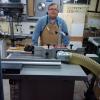My major pandemic project has been a new workbench. I'd bought the lumber a few years ago but hadn't had the time to complete it. It's almost done and I'm left with a few cutoffs from the douglas fir I used for the base. I was thinking about making an end-grain cutting board with them because a) I can't think of anything else off the top of my head to use them for and b) I've pretty much run out of scrap wood for small projects to keep busy. I generally stick to maple and walnut for cutting boards. A quick search reveals a wide range of opinions. Anyone want to chime in with theirs? Would I be wasting my admittedly low-value time?




 Reply With Quote
Reply With Quote



 And I really enjoy it. I've been hoarding a bunch of scrap and cutoffs to make a very nice end-grain board one of these days, myself.
And I really enjoy it. I've been hoarding a bunch of scrap and cutoffs to make a very nice end-grain board one of these days, myself.
